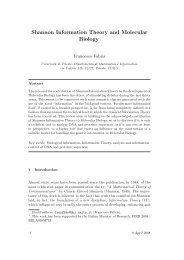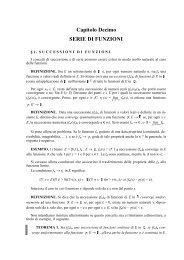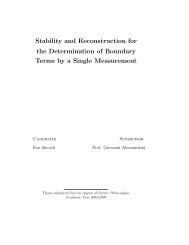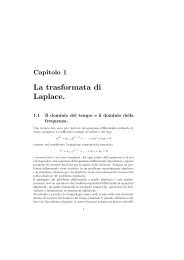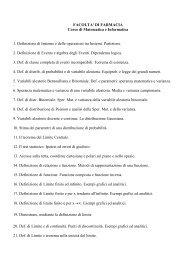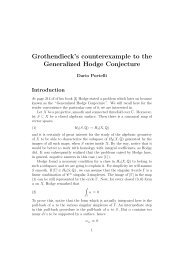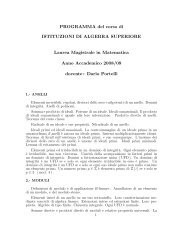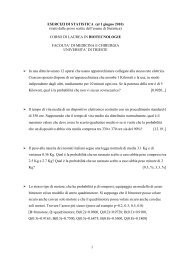20 Mezzetti5.2. Proposition. Let X ⊂ A n be an affine algebraic set, X be the projectiveclosure of X. ThenI h (X) = h I(X) := 〈 h F |F ∈ I(X)〉.Proof. Assume A n = U 0 ⊂ P n .Let F ∈ I h (X) be a homogeneous polynomial. If P(a 1 , . . ., a n ) ∈ X, then[1, a 1 , . . ., a n ] ∈ X, so F(1, a 1 , . . ., a n ) = 0 = a F(a 1 , . . ., a n ). Hence a F ∈ X.There exists k ≥ 0 such that F = (x k 0 )h ( a F) (see Proposition 3.2), so F ∈ h I(X).Hence I h (X) ⊂ h I(X).Conversely, if G ∈ I(X) and P(a 1 , . . ., a n ) ∈ X, then G(a 1 , . . ., a n ) = 0 =h G(1, a 1 , . . ., a n ), so h G ∈ I h (X) (here X is seen as a subset of P n ). So h I(X) ⊂I h (X). Since I h (X) = I h (X) (see Exercise 5.1), we have the claim.□In particular, if X is a hypersurface and I(X) = 〈F 〉, then I h (X) = 〈 h F 〉.Next example will show that, in general, it is not true that, if I(X) =〈F 1 , . . ., F r 〉, then h I(X) = 〈 h F 1 , . . ., h F r 〉. Only in the last twenty years, thanksto the development of symbolic algebra and in particular of the theory of Groebnerbases, the problem of characterizing the systems of generators of I(X), whosehomogeneization generates h I(X), has been solved.5.3. Example. The skew cubic.Let K be an algebraically closed field. The affine skew cubic is the followingclosed subset of A 3 : X = V (y − x 2 , z − x 3 ) (we use variables x, y, z). X is theimage of the map φ : A 1 → A 3 such that φ(t) = (t, t 2 , t 3 ). <strong>Note</strong> that φ : A 1 → Xis a homeomorphism (see Exercise 2.4). The ideal α = 〈y − x 2 , y − x 3 〉 defines Xand is prime: indeed the quotient ring K[x, y, z]/α is isomorphic to K[x], hencean integral domain. Therefore α is ra<strong>di</strong>cal so α = I(X).Let X be the projective closure of X in P 3 . We are going to prove that Xis the image of the map ψ : P 1 → P 3 such that ψ([λ, µ]) = [λ 3 , λ 2 µ, λµ 2 , µ 3 ]. Weidentify A 1 with the open subset of P 1 defined by λ ≠ 0 i.e. U 0 , and A 3 withthe open subset of P 3 defined by x 0 ≠ 0 (U 0 too). <strong>Note</strong> that ψ| A1 = φ, becauseψ([1, t]) = [1, t, t 2 , t 3 ] = via the identification of A 3 with U 0 = (t, t 2 , t 3 ) = φ(t).Moreover ψ([0, 1]) = [0, 0, 0, 1]. So ψ(P 1 ) = X ∪ {[0, 0, 0, 1]}.If G is a homogeneous polynomial of K[x 0 , x 1 , . . ., x 3 ] such that X ⊂ V P (G),then G(1, t, t 2 , t 3 ) = 0 ∀t ∈ K, so G(λ 3 , λ 2 µ, λµ 2 , µ 3 ) = 0 ∀µ ∈ K, ∀λ ∈ K ∗ .Since K is infinite, then G(λ 3 , λ 2 µ, λµ 2 , µ 3 ) is the zero polynomial in λ and µ, soG(0, 0, 0, 1) = 0 and V P (G) ⊃ ψ(P 1 ), therefore X ⊃ ψ(P 1 ).Conversely, it is easy to prove that ψ(P 1 ) is Zariski closed, in fact that ψ(P 1 ) =V P (x 2 1− x 0 x 2 , x 1 x 2 − x 0 x 3 , x 2 2− x 1 x 3 ). So ψ(P 1 ) = X.
Introduction to algebraic geometry 21The three polynomials F 0 := x 1 x 3 − x 2 2, F 1 := x 1 x 2 − x 0 x 3 , F 2 := x 0 x 2 − x 2 1are the 2 × 2 minors of the matrix( )x0 xM =1 x 2x 1 x 2 x 3with entries in K[x 0 , x 1 , . . ., x 3 ]. Let F = y −x 2 , G = z −x 3 be the two generatorsof I(X); h F = x 0 x 2 −x 2 1, h G = x 2 0x 3 −x 3 1, hence V P ( h F, h G) = V P (x 0 x 2 −x 2 1, x 2 0x 3 −x 3 1 ) ≠ X, because V P( h F, h G) contains the whole line V P (x 0 , x 1 ).We shall prove now the non-trivial fact:5.4. Proposition. I h (X) = 〈F 0 , F 1 , F 2 〉.Proof. For all integer number d ≥ 0, let I h (X) d := I h (X) ∩ K[x 0 , x 1 , . . ., x 3 ] d : itis a K-vector space of <strong>di</strong>mension ≤ ( )d+33 . We define a K-linear map ρd havingI h (X) d as kernel:ρ d : K[x 0 , x 1 , . . ., x 3 ] d → K[λ, µ] 3dsuch that ρ d (F) = F(λ 3 , λ 2 µ, λ 2 µ 2 , µ 3 ). Since ρ d is clearly surjective, we compute( ) d + 3<strong>di</strong>m I h (X) d = − (3d + 1) = (d 3 + 6d 2 − 7d)/6.3For d ≥ 2, we define now a second K-linear mapφ d : K[x 0 , x 1 , . . ., x 3 ] d−2 ⊕ K[x 0 , x 1 , . . ., x 3 ] d−2 ⊕ K[x 0 , x 1 , . . ., x 3 ] d−2 → I h (X) dsuch that φ d (G 0 , G 1 , G 2 ) = G 0 F 0 + G 1 F 1 + G 2 F 2 . Our aim is to prove that φ d issurjective. The elements of its kernel are called the syzygies of degree d amongthe polynomials F 0 , F 1 , F 2 . Two obvious syzygies of degree 3 are constructed bydeveloping, accor<strong>di</strong>ng to the Laplace rule, the determinant of the matrix obtainedrepeating one of the rows of M, for example⎛⎝ x ⎞0 x 1 x 2x 0 x 1 x 2⎠x 1 x 2 x 3We put H 1 = (x 0 , x 1 , x 2 ) and H 2 = (x 1 , x 2 , x 3 ), they both belong to ker φ 3 . <strong>Note</strong>that H 1 and H 2 give raise to syzygies of all degrees ≥ 3, in fact we can constructa third linear mapψ d : K[x 0 , x 1 , . . ., x 3 ] d−3 ⊕ K[x 0 , x 1 , . . ., x 3 ] d−3 → kerφ dputting ψ d (A, B) = H 1 A + H 2 B = (x 0 , x 1 , x 2 )A + (x 1 , x 2 , x 3 )B.



